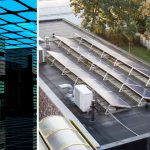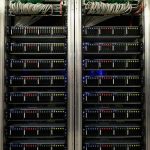
Some options to achieve energy-efficient data centers and reduce operating costs may include adjusting operating temperature, cloud infrastructure, storage hardware, and fan speed.
The power requirements for infrastructure in a data center can be costly, especially utility bills. For this reason, data center officials search for effective ways to address their power needs while increasing energy efficiency. One good example is Dubai’s flat-roof data center powered by solar energy. It is the largest solar-powered data center in the world.
Other energy-efficient data centers operate with CPUs, cooling systems, storage hardware, and other infrastructures that drain energy. As such, adjusting these infrastructures will boost energy efficiency.
Keep reading to learn more!
What Is a Data Center?
A data center is a facility that houses critical data and applications of organizations. Its design comprises a connection of storage and computing resources that facilitates the delivery of shared data and apps.
Furthermore, the design of a data center includes switches, firewalls, routers, app-delivery controllers, servers, and storage systems. It’s a computerized setup and requires efficient energy to operate, thus, draining the managers’ finance.
As such, the operators must employ effective ways to provide efficient energy for a data center without high expenses. These strategies will help trim energy waste, reduce operating costs, and enhance the overall energy consumption in the setup.
6 Best Ways to Achieve an Energy-Efficient Data Center
From reducing energy usage of IT equipment to optimizing HVAC systems, these strategies will be the best to reduce data center power consumption.
#1. – Consolidating Lightly-Used Servers
Most servers have little capacity, making some data centers demand more. However, combining the low-capacity servers into one can save energy and make up a durable server capacity.
Also, if there is unneeded hardware in the setup, removing them would positively impact energy efficiency in the setup and reduce cost. For instance, removing one server can save data center managers up to $1000 in energy and operating system licenses and $1,500 from the annual hardware maintenance costs.
#2. – Use Servers With Built-in Power Management Attributes
Several modern servers have a few energy-saving features that require activation to work. For instance, server processors can cut down power consumption in times of low operations, automatically disabling idle CPU cores temporarily and adjusting CPU speed.
Some other energy-efficient features in newer servers include efficient power supplies, cooling fans, enhanced DC volt regulators, and in-built power management. Data centers should consider replacing their older servers with newer auto-power-management servers.
#3. – Consider High-Efficiency Power Distribution Units (PDUs)
Power distribution units (PDUs) with more efficiency can trim energy losses more than conventional units. Also, newer ‘Smart’ PDUs now allow data center operators to monitor power usage.
Furthermore, PDUs increase the operation time of data centers while protecting sensitive equipment from damage by voltage rise. Apart from monitoring power usage, these PDUs will reduce the cost of replacing damaged IT equipment in the setup.
#4. – Consider UPS Systems With an Eco-Mode Feature
Uninterruptable power supply systems with the eco-mode feature can reduce energy loss in data centers thanks to their energy efficiency. An eco-mode UPS system can reduce electrical losses and even minimize energy usage.
Furthermore, this kind of UPS system can minimize data center energy costs by up to 2%, making them the best power infrastructure to consider.
#5. – Invest in Ideal Yet Cost-Effective Airflow Management
Improper airflow management can ruin the servers of a data center, drawing more expenses to the data center operators. Investing in inexpensive airflow management measures can be the best bet to avoid such a situation.
There are non-pricey diffusers, grommets, and even blanking panels that can prevent the mixture of cool and hot exhaust air in the setup. By providing the servers and equipment with cool airflow, they last longer and work more efficiently.
Also, server rack arrangement is vital to consider because it can reduce fan energy by 20% to 25%. Advisably, all the fronts of the sever should face one another and their backs. This will form cold and hot (exhaust) aisles in the setup.
Furthermore, data center operators can use Plexiglas panels or curtains to create demarcations between the fronts and backs of the servers. These are significant energy savings tips to consider.
#6. – Make Some Adjustments to the HVAC System
Investing in a water-side economizer for the Heating, Ventilation, and Air Conditioning (HVAC) system can help reduce the cost of mechanical chilled water by 70% and more. Not only will this reduce expenses, but it’ll also provide a sustainable water source for the HVAC system.
Furthermore, installing in-row or in-rack cooling systems will bring cold air directly or nearer to the servers. These systems will consume less energy in a server rack with high-energy density. Also, it’s three times better than conventional systems. The cooler the server racks, the longer they live.
Also, using natural air from outside and around the environment would be ideal as it’s free and durable. Data centers will spend less with this method.
There are many other ways modern and traditional data centers can make energy efficiency improvements. However, these can reduce energy costs and enhance the data center’s efficiency.
Frequently Asked Questions
Here are some questions and answers concerning energy consumption in data centers and how to reduce power consumption.
Can Airflow Management Reduce Energy Consumption in Data Centers?
Adequate airflow management can reduce energy consumption in data centers by enhancing the cooling, heating, ventilation, and air conditioning systems. Besides reducing energy consumption, it also boosts data center energy efficiency.
What Is PUE, and Which Is the Best for Data Centers?
PUE is the abbreviation for Power Usage Effectiveness. It’s the ratio of the overall power usage of a computer data center.
The best PUE value for data centers is 1.0. It indicates an ideal data center energy efficiency, where 100% of the facility’s power goes to the IT infrastructure. All energy-efficient data centers must have a 1.0 PUE value.
What Consumes More Energy in Data Centers?
Servers consume more energy in data centers as they’re more like the base of the setup. Also, cooling systems consume energy because they run to keep the servers cool during operations. However, the abovementioned ways can help reduce energy consumption and operating expenses in data centers.
Conclusion
Many money energy reduction strategies will emerge with more data centers emerging and seeking energy-saving strategies while reducing expenses. But, data center managers can consolidate low-capacity servers and utilize newer servers with built-in power management attributes.
Also, they can consider high-efficiency Power Distribution Units (PDUs) and invest in eco-mode integrated UPS systems.
Furthermore, airflow management and HVAC system adjustment can also enhance energy savings. Consider all these to achieve the most energy-efficient data center.









